Crisis Management in Tourism
24 Pages6118 Words489 Views
Added on 2023-06-05
About This Document
This report covers the introduction of the tourism sector in Indonesia, its contribution towards the economy of the country and several “Pull” factors of destination. The unit will also cover the crisis in the tourism sector of Indonesia and its significant impact along with key vulnerability and suggestion for planning growth in tourism in future. In this report strategic crisis management is also described, which refers to the capability of the government or any authority to deal with the crisis by reducing its impact to a minimum level and bring back the pre-crisis situation.
Crisis Management in Tourism
Added on 2023-06-05
ShareRelated Documents
Running head: CRISIS MANAGEMENT IN TOURISM
Crisis Management in Tourism
Name of the Student:
Name of the University:
Author note:
Crisis Management in Tourism
Name of the Student:
Name of the University:
Author note:

1CRISIS MANAGEMENT IN TOURISM
Executive summary
Tourism destinations, which encompass multiple hospitality products, are highly susceptible to
crises and disasters. While these negative events have the ability to weaken or destroy a
competitive advantage of tourism destinations, proper planning reduces the likelihood of
occurrence and severity of crises. The report will cover the introduction of the tourism sector in
Indonesia, its contribution towards the economy of the country and several “Pull” factors of
destination. The unit will also cover the crisis in the tourism sector of Indonesia and its
significant impact along with key vulnerability and suggestion for planning growth in tourism in
future. In this report strategic crisis management is also described, which refers to the capability
of the government or any authority to deal with the crisis by reducing its impact to a minimum
level and bring back the pre-crisis situation. Thus various strategies are implemented and various
instruments are used in strategic crisis management. This report highlights the key strategies that
the government and tourism authorities can consider while managing a crisis, and the key
instruments, such as, communication, products, prices and distribution policies that should be
applied in appropriate manner during the crisis and recovery stages. Lastly, based on the report,
some recommendations have been designed to reduce the crisis, such as, terrorism and poor
infrastructure in Indonesia to improve the growth of the tourism industry.
Executive summary
Tourism destinations, which encompass multiple hospitality products, are highly susceptible to
crises and disasters. While these negative events have the ability to weaken or destroy a
competitive advantage of tourism destinations, proper planning reduces the likelihood of
occurrence and severity of crises. The report will cover the introduction of the tourism sector in
Indonesia, its contribution towards the economy of the country and several “Pull” factors of
destination. The unit will also cover the crisis in the tourism sector of Indonesia and its
significant impact along with key vulnerability and suggestion for planning growth in tourism in
future. In this report strategic crisis management is also described, which refers to the capability
of the government or any authority to deal with the crisis by reducing its impact to a minimum
level and bring back the pre-crisis situation. Thus various strategies are implemented and various
instruments are used in strategic crisis management. This report highlights the key strategies that
the government and tourism authorities can consider while managing a crisis, and the key
instruments, such as, communication, products, prices and distribution policies that should be
applied in appropriate manner during the crisis and recovery stages. Lastly, based on the report,
some recommendations have been designed to reduce the crisis, such as, terrorism and poor
infrastructure in Indonesia to improve the growth of the tourism industry.
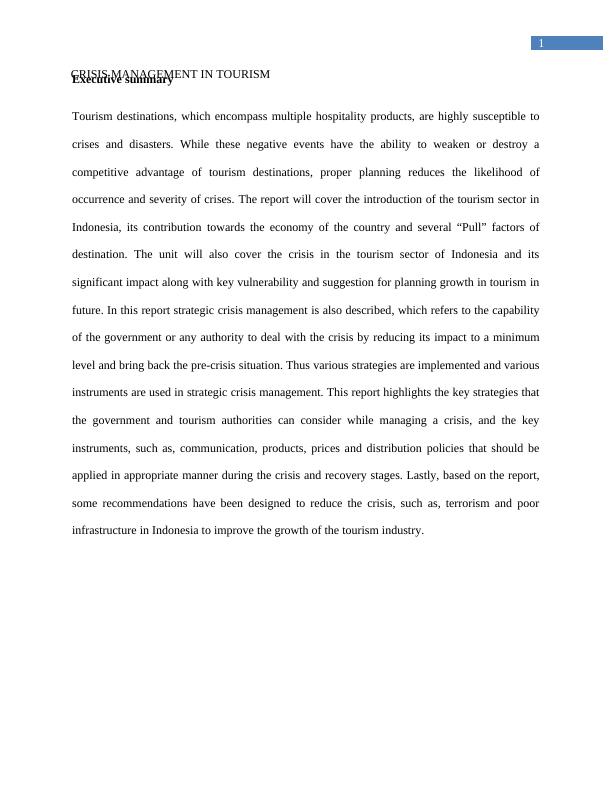
2CRISIS MANAGEMENT IN TOURISM
Table of Contents
Introduction...................................................................................................................................3
Part A.............................................................................................................................................4
Destination ‘pull’ factors.............................................................................................................4
Crises and their impact on ‘pull’ factors.................................................................................5
Key vulnerabilities.......................................................................................................................7
Part B..............................................................................................................................................9
Strategic crisis management.......................................................................................................9
Preventive crisis management, including crisis anticipation and preventive crisis........10
Proposed crisis management instruments to be implemented during the crisis, to
reduce its impact and severity..................................................................................................12
Key strategies to be implemented in the crisis recovery stage............................................15
Conclusion and recommendations...........................................................................................16
References....................................................................................................................................18
Table of Contents
Introduction...................................................................................................................................3
Part A.............................................................................................................................................4
Destination ‘pull’ factors.............................................................................................................4
Crises and their impact on ‘pull’ factors.................................................................................5
Key vulnerabilities.......................................................................................................................7
Part B..............................................................................................................................................9
Strategic crisis management.......................................................................................................9
Preventive crisis management, including crisis anticipation and preventive crisis........10
Proposed crisis management instruments to be implemented during the crisis, to
reduce its impact and severity..................................................................................................12
Key strategies to be implemented in the crisis recovery stage............................................15
Conclusion and recommendations...........................................................................................16
References....................................................................................................................................18
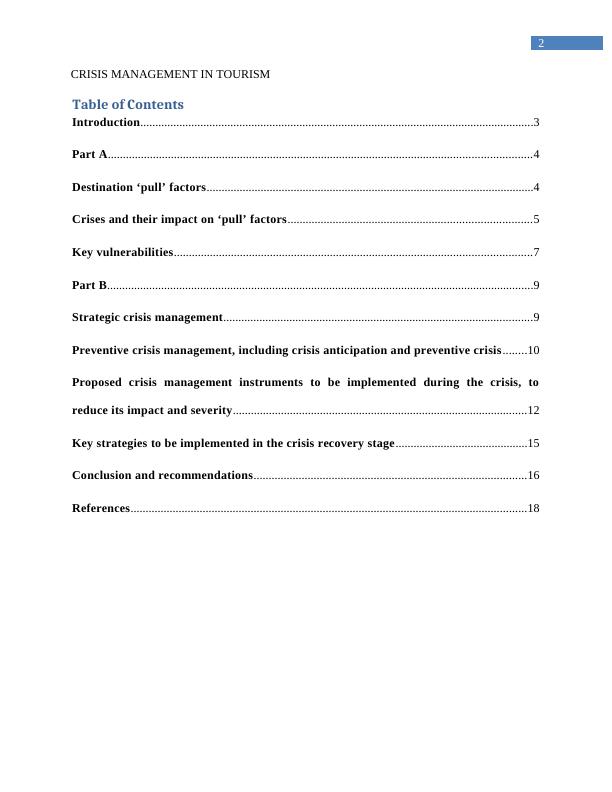
3CRISIS MANAGEMENT IN TOURISM
Introduction
Indonesia tourism has both cultural and natural component that widely includes unique
heritage with a combination of tropical climate, a wide range of archipelago having 17,508
islands (Pettina, 2016). The country ranks second in the list of largest shorelines in the world
(54,716km), following only Canada (202,080km) (Smith, 2017). The country offers many
attractive tourist places in the South East Asia. The key international markets for the tourism
sector of Indonesia are China, Singapore, Australia, Malaysia and Japan. These are followed by
the other countries in Asia, such as, India, Thailand, Taiwan and Philippines, countries from
Europe, such as, UK, France, Germany, and Russia, and the United States. In 2017, the total
international footfall in Indonesia was more than 14 million, with an average stay of 21.88 days
(bps.go.id, 2018). Tourism and hospitality sector in Indonesia contributes approximately USD
28.2 billion to the GDP of Indonesia in 2017 and accounts for around 4% of the total economy
(Investments, 2018).
Figure 1: Tourist Investment in Indonesia
(Source: Forces shaping the future of work in a changing regional economy, 2018)
Introduction
Indonesia tourism has both cultural and natural component that widely includes unique
heritage with a combination of tropical climate, a wide range of archipelago having 17,508
islands (Pettina, 2016). The country ranks second in the list of largest shorelines in the world
(54,716km), following only Canada (202,080km) (Smith, 2017). The country offers many
attractive tourist places in the South East Asia. The key international markets for the tourism
sector of Indonesia are China, Singapore, Australia, Malaysia and Japan. These are followed by
the other countries in Asia, such as, India, Thailand, Taiwan and Philippines, countries from
Europe, such as, UK, France, Germany, and Russia, and the United States. In 2017, the total
international footfall in Indonesia was more than 14 million, with an average stay of 21.88 days
(bps.go.id, 2018). Tourism and hospitality sector in Indonesia contributes approximately USD
28.2 billion to the GDP of Indonesia in 2017 and accounts for around 4% of the total economy
(Investments, 2018).
Figure 1: Tourist Investment in Indonesia
(Source: Forces shaping the future of work in a changing regional economy, 2018)
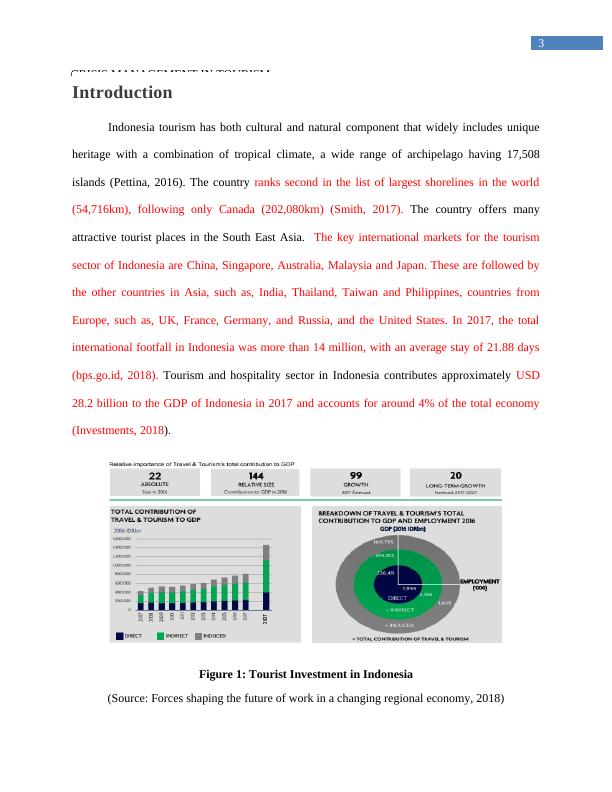
4CRISIS MANAGEMENT IN TOURISM
Part A
Destination ‘pull’ factors
Pull factors in tourism describe why people travel from one place to another. According
to Mason (2015), pull factors include those elements that attract the tourist to move to a
particular tourist destination. These include the attraction points, economic and political stability,
level of infrastructural development regarding the facilities etc. (Boniface, Cooper and Cooper,
2016). These are mainly the supply-side factors of tourism. According to Garau-Vadell, Díaz-
Armas and Gutierrez-Taño (2014), Weaver and Lawton classified the destination pull factors
into the following categories:
geographical proximity to markets;
accessibility to markets;
availability of attractions;
cultural links;
availability of services;
affordability;
peace, stability and safety;
a positive market image and
pro-tourism policies which go further to enhance attraction to the destination (Azman and
Chan, 2010)
Part A
Destination ‘pull’ factors
Pull factors in tourism describe why people travel from one place to another. According
to Mason (2015), pull factors include those elements that attract the tourist to move to a
particular tourist destination. These include the attraction points, economic and political stability,
level of infrastructural development regarding the facilities etc. (Boniface, Cooper and Cooper,
2016). These are mainly the supply-side factors of tourism. According to Garau-Vadell, Díaz-
Armas and Gutierrez-Taño (2014), Weaver and Lawton classified the destination pull factors
into the following categories:
geographical proximity to markets;
accessibility to markets;
availability of attractions;
cultural links;
availability of services;
affordability;
peace, stability and safety;
a positive market image and
pro-tourism policies which go further to enhance attraction to the destination (Azman and
Chan, 2010)
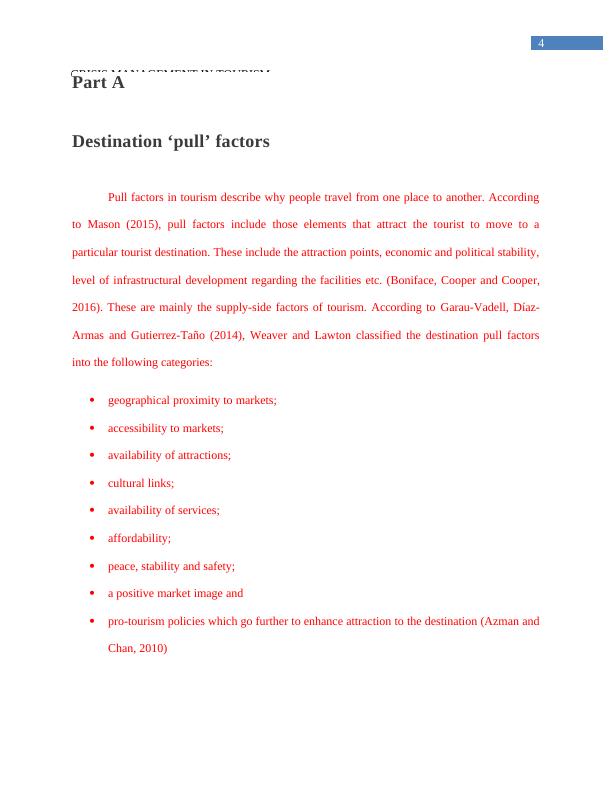
5CRISIS MANAGEMENT IN TOURISM
A closer proximity to Australia, New Zealand and South East Asia attracts many tourists
to Indonesia. Accessibility to the destination is a major influencing factor. Although the major
tourist destinations in Indonesia are easily accessible by road, sea-ports and airports, there are
many attractions which are in the interiors. There are plenty of natural and man-made attractions
in the country.
International standard services are available in the country, as it has taken the initiative to
develop its hotels and beach resorts in some fashionable destination like- Bali island as a prime
destination. The economy and political conditions are stable and being a developing nation, the
products and services are easily affordable to the international tourists. It has been investing in
infrastructure and developing the tourism facilities and services. The social environment is
generally safe, although there are some occasional terrorist attacks. It has a culturally positive
and vibrant image, with historical and cultural remnants, beautiful countryside and beaches,
interesting nightlife in Bali and Jakarta, and the exquisite Indonesian cuisine to splurge on. The
pro-tourism policies in Indonesia, such as, visa on arrival, easy money exchange, and tourist
friendly policies are helpful in attracting more international tourists to achieve a sustaining
growth. For example, the government of Indonesia also revised its policy of free visa-access in
2015 (Joshi et al., 2017).
Crises and their impact on ‘pull’ factors
The organization of world tourism describes “crises” as unexpected situation/events,
which affects traveller’s confidence to travel to a destination and interfere with their ability to
continue the process (Mat Som et al., 2014). Poor infrastructure is one of the major crises that
are causing problems for tourism in Indonesia. Poor infrastructure significantly affects the pull
A closer proximity to Australia, New Zealand and South East Asia attracts many tourists
to Indonesia. Accessibility to the destination is a major influencing factor. Although the major
tourist destinations in Indonesia are easily accessible by road, sea-ports and airports, there are
many attractions which are in the interiors. There are plenty of natural and man-made attractions
in the country.
International standard services are available in the country, as it has taken the initiative to
develop its hotels and beach resorts in some fashionable destination like- Bali island as a prime
destination. The economy and political conditions are stable and being a developing nation, the
products and services are easily affordable to the international tourists. It has been investing in
infrastructure and developing the tourism facilities and services. The social environment is
generally safe, although there are some occasional terrorist attacks. It has a culturally positive
and vibrant image, with historical and cultural remnants, beautiful countryside and beaches,
interesting nightlife in Bali and Jakarta, and the exquisite Indonesian cuisine to splurge on. The
pro-tourism policies in Indonesia, such as, visa on arrival, easy money exchange, and tourist
friendly policies are helpful in attracting more international tourists to achieve a sustaining
growth. For example, the government of Indonesia also revised its policy of free visa-access in
2015 (Joshi et al., 2017).
Crises and their impact on ‘pull’ factors
The organization of world tourism describes “crises” as unexpected situation/events,
which affects traveller’s confidence to travel to a destination and interfere with their ability to
continue the process (Mat Som et al., 2014). Poor infrastructure is one of the major crises that
are causing problems for tourism in Indonesia. Poor infrastructure significantly affects the pull
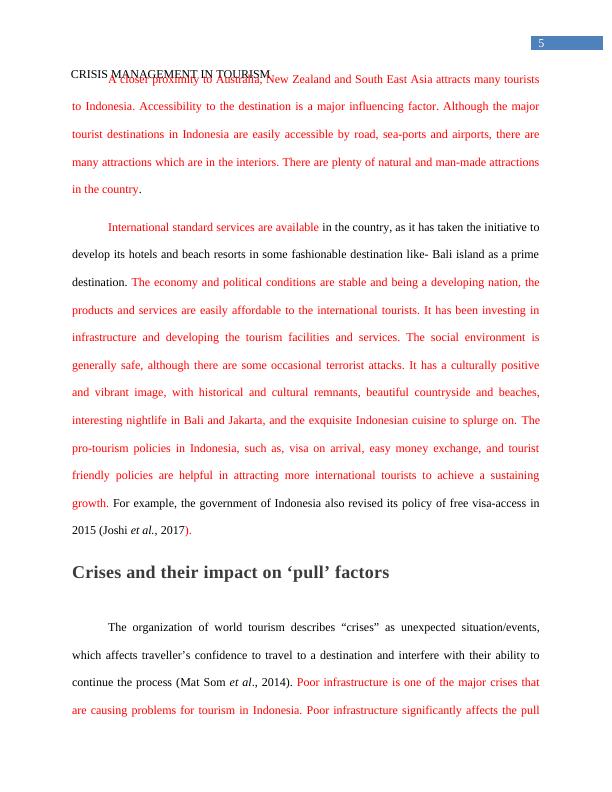
End of preview
Want to access all the pages? Upload your documents or become a member.
Related Documents
Crisis and Disaster in Tourism, Event and Hospitality Industrylg...
|12
|3248
|472
Crisis Management in Tourism Due to Coronavirus in Chinalg...
|21
|2459
|24
Emerging Issues in Hospitality and Tourismlg...
|7
|2106
|93
Impact of Coronavirus on Global Hospitality and Tourism Industrieslg...
|1
|1916
|2
Travel Alberta Business Strategy 2011-2014lg...
|4
|1167
|499
COVID-19 impacts on Hospitality Sectorlg...
|9
|2407
|88
